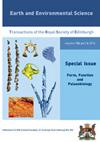青海省木里煤田天然气水合物稳定带
IF 1.2
4区 地球科学
Q4 GEOSCIENCES, MULTIDISCIPLINARY
Earth and Environmental Science Transactions of the Royal Society of Edinburgh
Pub Date : 2021-11-29
DOI:10.1017/S1755691021000311
引用次数: 0
摘要
天然气水合物稳定带(GHSZ)是天然气水合物成藏的必要条件,受天然气组分、地温梯度和多年冻土厚度三个主要因素的控制。根据木里煤田钻探水合物样品的气体组分,采用Sloan天然气水合物相平衡程序(CSMHYD)计算了天然气水合物相平衡曲线。通过对煤田钻孔温度数据的处理,获得了多年冻土厚度、地温梯度等重要数据。在上述基础数据的基础上,通过编程计算了单孔的GHSZ参数。木里煤田85口井的GHSZ平均厚度约为1000 m,表明天然气水合物的赋存空间非常广阔。利用木日煤田单孔资料绘制的GHSZ底深等值线图,揭示了GHSZ的区域分布特征,确定了GHSZ底埋深在150 ~ 1500 m的3个有利天然气水合物赋生区,分别为巨户耕矿区南部、多所公马矿区中部和雪火里矿区东部。本文章由计算机程序翻译,如有差异,请以英文原文为准。
Gas hydrate stability zone in Muri coalfield, Qinghai Province, China
ABSTRACT The gas hydrate stability zone (GHSZ) is the essential condition for gas hydrate accumulation, which is controlled by three main factors: gas component, geothermal gradient and permafrost thickness. Based on the gas component of hydrate samples from drilling in Muri coalfield, the gas hydrate phase equilibrium curve was calculated using Sloan's natural gas hydrate phase equilibrium procedure (CSMHYD) program. Through temperature data processing of coalfield boreholes, some important data such as thickness of permafrost and geothermal gradient were obtained. The GHSZ parameters of a single borehole were calculated by programming based on the above basic data. The average thickness of GHSZ of 85 boreholes in Muri coalfield amounted to approximately 1000 m, indicating very broad space for gas hydrate occurrence. The isogram of GHSZ bottom depth drawn from single borehole data in Muri coalfield demonstrated the regional distribution characteristics of GHSZ, and identified three favourable areas of gas hydrate occurrence where the bottom of GHSZ had a burial depth >1500 m – namely, the southern part of Juhugeng Mining Area, the middle part of Duosuogongma Mining Area and the eastern part of Xuehuoli Mining Area.
求助全文
通过发布文献求助,成功后即可免费获取论文全文。
去求助
来源期刊
CiteScore
2.00
自引率
0.00%
发文量
21
期刊介绍:
Earth and Environmental Science Transactions (formerly Transactions of the Royal Society of Edinburgh: Earth Sciences) is a general earth sciences journal publishing a comprehensive selection of substantial peer-reviewed research papers, reviews and short communications of international standard across the broad spectrum of the Earth and its surface environments. The journal prides itself on the quality of its graphics and photographic reproduction. The Editors are keen to encourage interdisciplinary papers and Transactions also publishes occasional special symposia and invited volumes of specific interest.
We are currently in the process of digitising the archive of RSE Publications, and the archive of the Transactions, dating back to 1788, will be available from the back issues link on this site.

 求助内容:
求助内容: 应助结果提醒方式:
应助结果提醒方式:


